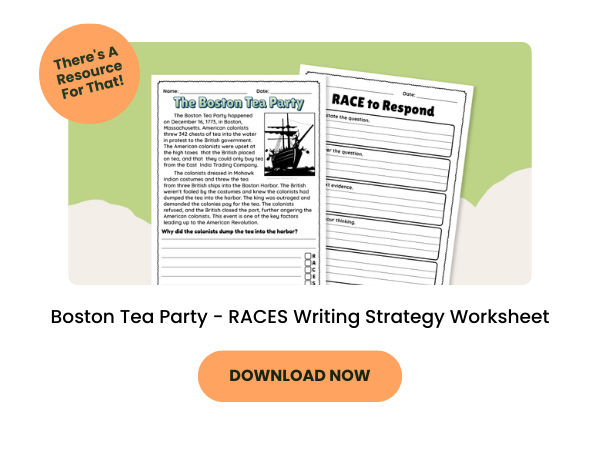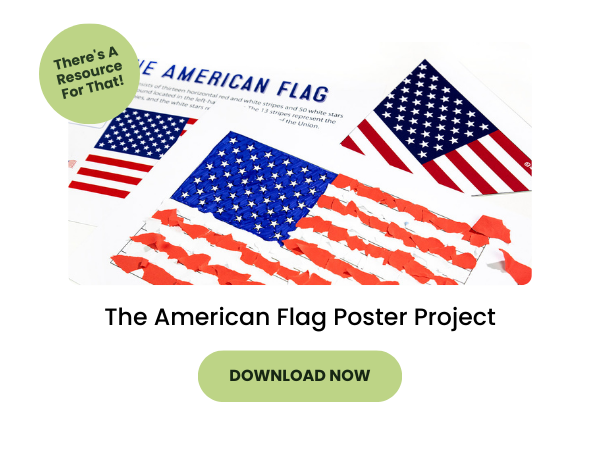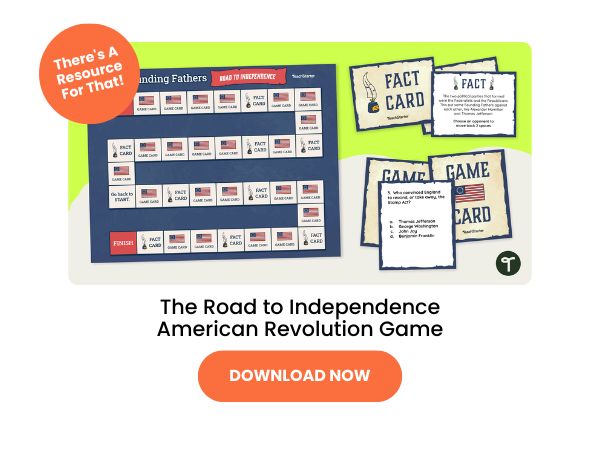Most kids know that July 4th is famous, but do they know any Revolutionary War facts leading up to the origin of that date? Sometimes a quick fact or two can help generate interest in broader historical periods — such as the American Revolution — and give you a helpful boost in the classroom!
The Revolutionary War may have occurred more than 200 years ago, but there are some fascinating events and people that defined the start of the America that we know today. Did your students know pirates helped the revolutionary cause? How about the spy ring that helped George Washington win the war? Read on for fun facts and answers to some of the biggest questions about the war, from how the American Revolution influenced the French Revolution to how the Stamp Act led to the revolution.
The teachers at Teach Starter have not only selected these fun facts for you and your students, but they’ve also designed curriculum-aligned resources to bring this integral period of American history to life in your 21st-century classroom.
Need to dive right into revolutionary resources? Browse our Revolutionary War learning area for relevant worksheets, activities, crafts, comprehension strategies and much more.
Revolutionary War Facts for Kids
Use the following facts with your students to introduce new lessons, discuss as a class or use as trivia! Keep reading for more ideas on how to use them in the classroom, plus related books you can add to your lessons or classroom library.
1. The British ruled over the 13 American colonies for more than 168 years, but it only took the colonists seven years to overthrow the British government!
2. Georgia was the last colony to join the 13 colonies in 1733.
3. The Stamp Act imposed upon colonists by the British government backfired as it helped lead to the Revolutionary War. The British Empire saw the colonies as a form of income to help them with their debt from the French and Indian War. They taxed colonists on all imported goods (including paper products under The Stamp Act) which led to protests such as burning paper in the streets and boycotting British products.
4. When British soldiers opened fire on a crowd of angry colonists on March 5, 1770, they caused what we now call The Boston Massacre. This violent event is considered one of the major events leading up to the Revolutionary War, but you might just be surprised to hear who came out to act as a defense attorney for those British soldiers. It was none other than John Adams, a future American president!
5. The Boston Tea Party wasn’t a group of people sitting down for a cup of tea; it was actually a form of rebellion! Great Britain taxed colonists on goods that were shipped to them (such as paper, paint and tea) that were part of the Townshend Acts. However, all these taxes were lifted except for tea in 1770, which enraged the colonists. They eventually became so fed up that they dumped 300 chests of tea into Boston Harbor on December 16, 1773. On board the ship the Fortune, a second Boston Tea Party occurred in March 1774. This time, only 30 chests of tea were dumped into the water.
6. The tea thrown in the Boston Harbor was mostly green tea from China. Although the East India Company exported tea to the British colonies, it didn’t install its first tea plantations in India until the 1830s.
7. Before he became the first president of the United States, George Washington served as head of the army for five years against the British during the Revolutionary War.
8. When voluntary enlistments were low later in the war, many states offered freedom to enslaved people, but only if they fought on the Continental side.
9. More soldiers died from a disease called smallpox during the Revolutionary War than actually fighting the British. General George Washington made the controversial decision to require his troops to be inoculated to stop the spread of the disease among revolutionaries.
10. Britain defeated France in the French and Indian War, which resulted in them losing their territories in North America. To humiliate and gain revenge against Britain, France helped the revolutionary cause, ultimately helping American soldiers gain independence.
11. Paul Revere is most famous for his “midnight ride” on horseback to warn patriots of impending British forces, but did you know he didn’t ride alone? Revere rode with two other men: William Dawes and Samuel Prescott. Another famous rider, also known as the “female Paul Revere,” was Sybil Ludington. This 16-year-old helped warn her father’s (Colonel Ludington) men that the British had attacked Danbury, Connecticut.
12. Those involved in the Revolutionary War developed many monikers and names as the war developed. Here are some terms to be aware of:
- Redcoats, lobster backs, regulars and the Crown all referred to British soldiers.
- Loyalists, Royalists, Tories or the King’s Men were names that referred to those who lived in the colonies and remained faithful to the Crown or the British government.
- Patriots, revolutionaries, continentals, rebels, Yankees, Whigs and colonials were all names used for the colonists living in the colonies who rebelled against the British government.
13. American soldiers were also known as Minutemen because they were prepared to fight at a “minute’s notice.”
14. Under normal circumstances, the following daily rations were supposed to be given to each soldier:
- 1 1/2 pounds of flour or bread
- 1 pound of fish or beef
- 1 gill of whisky (which equals 4 ounces)
15. Tar and feathering was a common form of public humiliation and punishment in colonial America that had been used in Europe since the Middle Ages. The victims, often loyalists and tax collectors, would be stripped of their clothing before being covered in hot pine tar and feathers.
16. Thousands of women traveled with the Continental Army working as cooks, laundresses, nurses, couriers and even spies!
17. The Culper Spy Ring played an important role during the Revolutionary War and no spies were ever unmasked! Benjamin Tallmadge was the head of military intelligence thanks to George Washington and formed the ring with friends he met at school. The ring operated around New York for five years and uncovered important information, such as calling out the suspicions of British spy John André.
18. George Washington and his commanders used invisible ink to send messages throughout the war! This ink was made with water and ferrous sulfate, which required heat to be able to read.
19. “Molly Pitcher,” or Mary Ludwig Hays McCauley, is one of the most famous women of the war. She carried water to tired American soldiers and to cool cannons during the Battle of Monmouth. Legend has it that Pitcher took her husband’s place at the cannon for the rest of the battle after he was wounded.
20. Pirates — or privateers — fought for the Revolutionary cause by disrupting British ships throughout the war. By the end of the Revolutionary War, privateers stole about $18 million, which is about $302 million in today’s money.
21. A number of British soldiers spent time acting on stage in cities they controlled, including New York, Philadelphia and Boston. For some, theater was an escape and helped soldiers cope with living in a strange country different from their own.
22. Betsy Ross is often credited with sewing the first American flag, but no official documentation confirms it. Some historians believe that Francis Hopkinson, a signer of the Declaration of Independence and New Jersey delegate to the Continental Congress, is the real designer of our flag.
23. General Benedict Arnold was a famous figure of the Revolutionary War, first fighting for the American side but then becoming a “turncoat” when he switched his loyalties to the British. A turncoat describes a traitor — a person who deserts one group to join the opposing one.
24. The Continental Congress officially adopted the Declaration of Independence on July 4, 1776. Recognize the date? We celebrate the 4th of July each year to honor the date when colonists declared their desire to be independent of British rule.
25. Only 200 original copies of the Declaration of Independence were ever printed. The National Archives in Washington D.C. displays one fully signed and preserved copy.
26. The success of the American Revolution helped spark the French Revolution. Americans’ ideas of democracy, independence and enlightenment resonated with the French people who were struggling in a weak economy and ruled by an unpopular monarchy.
How to Use These Revolutionary War Facts in the Classroom
- Write one (or more) of the above facts on the whiteboard during your Revolutionary War unit to spark discussion and introductions to different lesson plans.
- Have your students recreate a map of the 13 colonies or of the East Coast, Atlantic Ocean and England. By having kids draw out their own map will help reinforce their geography of the Revolutionary War while also practicing fine motor skills.
- Watch Beyond the Battlefield with your class: a virtual field trip of the Museum of the American Revolution hosted by Scholastic.
- Research your local area and see if there are any Revolutionary War reenactments you can watch for a class field trip.
- Play The Road to Independence: American Revolution Game with our printable PDF. This is a fun way for kids to review their historical facts in board game form.
- Challenge your students to pretend they are a soldier during the Revolutionary War and want to write a letter to their family back home. Go a step further after writing and have your kids crumple up their letters, soak in a tea bath and dry to make them look old!
- Explore maps, videos and articles with your class through National Geographic’s American Revolution page intended for kids in grades 3-12+.
- Create a new Declaration of Independence: Challenge your class to create an updated Declaration of Independence. They can do this individually or in small groups, deciding the most important wants and needs of the American people.
- Choose an episode from PBS Kids, Liberty’s Kids, as a fun way to introduce or reinforce lessons about the Revolutionary War. Voices for the show’s characters include Walter Cronkite as Benjamin Franklin, Billy Crystal as John Adams and Annette Bening as Abigail Adams.












Comments